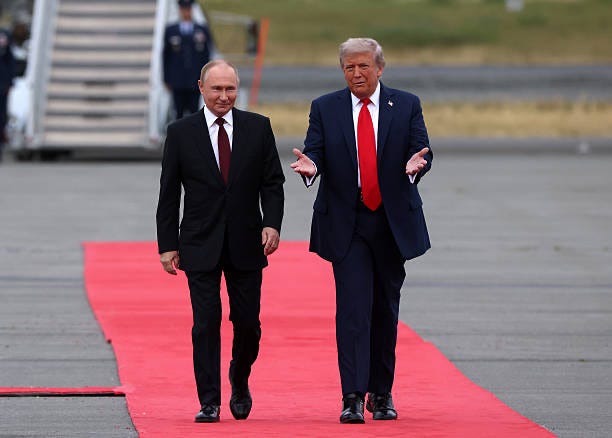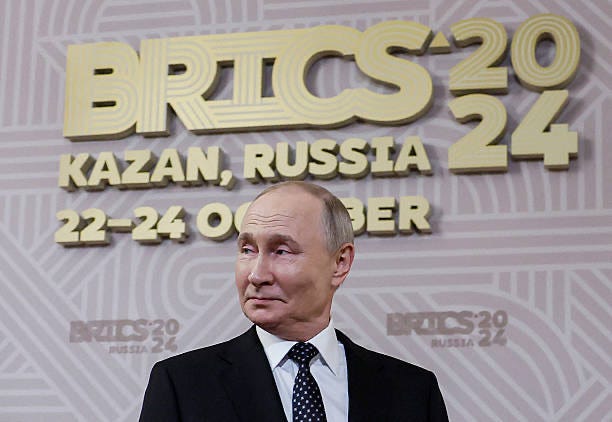“History sometimes compresses itself into a single image. The image of Donald Trump sitting in the Oval Office, summoning the leaders of Europe and Ukraine to his table, after meeting Vladimir Putin in Alaska, is one such moment. It was not merely diplomacy, but the staging of a new order — one where the United States reasserts dominance over Europe, Russia is courted as a sovereign equal, and China watches the game unfold.”
The Oval Office as Theater of Dominance
In politics, symbolism is strategy. When Donald Trump invited the leaders of Europe and Volodymyr Zelensky to the Oval Office, he was not convening allies, but subjects. Around his table sat the European Union — stripped of its illusions of sovereignty — and Ukraine, exhausted and dependent. In that moment, the hierarchy of the Western world was made visible. The United States remained the center of gravity; Europe was provincial; Ukraine was a dependent protectorate.
The Oval Office scene marked more than a diplomatic gathering. It was a deliberate display of American primacy, a reminder that Washington still commands the Western hemisphere and Western Europe alike. After years of U.S. retreat, hesitation, and decline, Trump staged a tableau of power. He positioned himself as the arbiter not only of Ukraine’s fate, but of Europe’s place in the world. The message was simple: the word still belongs to America.
Alaska as Symbol and Frontier
The choice of Alaska for the Trump–Putin summit was no accident. Alaska is more than geography; it is memory. Once Russian land, sold to Washington in 1867, it carries within it the symbolic frontier between two empires. By meeting there, Trump and Putin invoked a geography of history — where the old Russian frontier meets the American frontier, and where the map of Eurasia bends toward the Pacific.
Alaska symbolized a threshold. It was a reminder that the destinies of America and Russia cannot be separated, that their confrontation or cooperation defines the structure of global politics. By choosing Alaska, Trump invited Putin to a meeting of equals on a stage of contested memory, signaling that Moscow was not being summoned as a supplicant but as a co-architect of the world order.
The Fate of Ukraine: From Battlefield to Bargaining Chip
The war in Ukraine, once framed as an existential struggle for European security, has now been reduced to a bargaining chip in the grander negotiation between Washington and Moscow. Ukraine’s sacrifices on the battlefield, the devastation of its cities, and the suffering of its people now risk being condensed into a single formula: neutrality, partition, or federalization.
Zelensky’s presence in the Oval Office was telling. He was not an equal partner, but a witness to the deals being shaped above him. For the United States, Ukraine has become less about victory and more about leverage. For Russia, Ukraine is no longer just about territory but about survival of sovereignty against NATO’s eastward expansion. The likely outcome is a hybrid: a fragmented Ukraine, denied full sovereignty, trapped between Russian security demands and American calculations. In other words, Ukraine may survive as a state, but not as a nation in full control of its destiny.
Europe’s Humiliation and the End of Illusions
If Ukraine was diminished, Europe was humiliated. The Oval Office tableau exposed the truth: the European Union is not a sovereign actor, but an appendage of American strategy. Macron’s dreams of “strategic autonomy” were exposed as fantasies. Merkel’s legacy of balancing between Washington and Moscow is buried. In Alaska and in Washington, Europe was not a decision-maker, but a chorus line.
This humiliation is more than symbolic. Europe’s economic and energy crises, worsened by the war in Ukraine and its sanctions against Russia, have stripped it of strategic independence. The Oval Office meeting marked the final confirmation: Europe has no word of its own. Its leaders travel not as sovereign actors but as envoys to the American throne.
The Seduction of the West and the Russian Dilemma
Russia now stands at a crossroads. The Western offer is seductive: reintegration into global finance, access to capital markets, technological cooperation, and the lifting of sanctions. The United States can dangle before Moscow the promise of “normalization” — the same promise it once offered China in the 1970s.
But Russia knows the price. To re-enter the Western orbit risks a slow erosion of sovereignty. Putinism itself — as an ideology of sovereignty, national identity, and resistance to Western domination — would be at stake. To resist seduction, Russia must remain faithful to its BRICS trajectory, deepening ties with China, India, and the Global South. Yet even within Moscow’s elites, there are those who remember the comforts of Westernization, who see in Europe’s markets and in America’s capital not danger, but opportunity.
The dilemma is existential: is Russia to be a Eurasian power building a multipolar world, or a re-Westernized state, once again tied to the very system that sought to isolate and break it?
Energy, Minerals, and the Economics of Peace
Peace is never just politics; it is economics. If the U.S. and Russia reach an understanding, the global energy map will be redrawn. Russian gas could once again flow to Europe, not under duress but under new terms. Rare earth materials, critical to the green transition, could become instruments of bargaining. Russia’s frozen assets, locked in Western banks, could be partially unfrozen in exchange for concessions.
But the real question is deeper: will Russia re-enter the Western banking system, or will it maintain its BRICS-led alternative? Western integration is seductive — offering immediate relief. BRICS development is slow, uncertain, but sovereign. The choice will define not only Russia’s economy but its place in the new order.
China and the Strategic Triangle
In the background looms China. Washington knows it cannot fight both Russia and China at once. The Alaska meeting was thus a strategic calculation: better to attract Russia than to push it deeper into Beijing’s orbit. But is it too late?
Russia’s dependence on Chinese markets, its military cooperation with Beijing, and its reliance on the yuan as a trading currency suggest a bond that cannot be easily undone. Yet Russia is wary of becoming China’s junior partner. In this lies the paradox: America’s seduction is dangerous, but China’s embrace is suffocating. Russia must walk a tightrope between the two — asserting independence without isolation.
The Zangezur Corridor and the Eurasian Chessboard
Beyond Ukraine lies another chessboard: the Caucasus. The U.S.-backed push for a Zangezur Corridor linking Azerbaijan to Turkey threatens to bypass Russia and weaken Iran. For Moscow, this corridor is more than logistics; it is geopolitics. It risks cutting Russia off from Armenia, undermining its influence in the Caucasus, and destabilizing Iran, its uneasy partner.
If Washington secures the corridor, it will have planted a wedge in Eurasia itself — a line that isolates Russia from its southern flank and weakens the axis of resistance that connects Tehran, Moscow, and Damascus. The battle over Ukraine may end, but the Caucasus could become the next front in the struggle for Eurasian sovereignty.
The United States as Peacemaker and Hegemon
There is a paradox at the heart of Alaska. The United States presents itself as a peacemaker, bringing an end to Europe’s bloodiest war since 1945. Yet at the same time, it mobilizes naval forces toward Venezuela, tightening its grip on Latin America. The message is clear: peace in one theater does not mean humility in another. America may court Russia, but it will not renounce hegemony.
The contradiction is naked: the same hand that signs peace in Alaska commands fleets in the Caribbean. This is not an abdication of empire, but a recalibration of it. The United States is rebranding hegemony as peacemaking.
Russia’s Internal Horizon: Identity and Sovereignty
Beyond geopolitics lies a deeper question: what is Russia? The war in Ukraine has hardened Russian identity. Orthodoxy, nationalism, and sovereignty have fused into a narrative of resistance. Yet beneath the surface lies fragility: demographic decline, elite corruption, and a youth torn between Western consumerism and Russian traditionalism.
Putinism is not eternal, but for now it remains necessary. Without Putin’s synthesis of power, sovereignty, and identity, Russia risks disintegration. The Alaska meeting, therefore, was not just about foreign policy; it was about Russia’s very being. Will it remain a sovereign civilization-state, or will it succumb to Western seduction and internal fragility?
Multipolarity After Alaska
The Alaska summit revealed a simple truth: the world is no longer unipolar. It is no longer bipolar either. It is triangular. The United States, Russia, and China form the three poles of global power. Europe is humiliated, reduced to an appendage. The Global South watches, calculating opportunities.
The postwar order in Ukraine will not only decide borders. It will decide the grammar of world politics. If America and Russia reconcile, China will feel the pressure. If Russia resists seduction, BRICS will deepen. If Europe remains humiliated, the myth of Western unity will collapse.
What is certain is that Alaska was not just a meeting. It was perhaps the staging of the new multipolar age.





